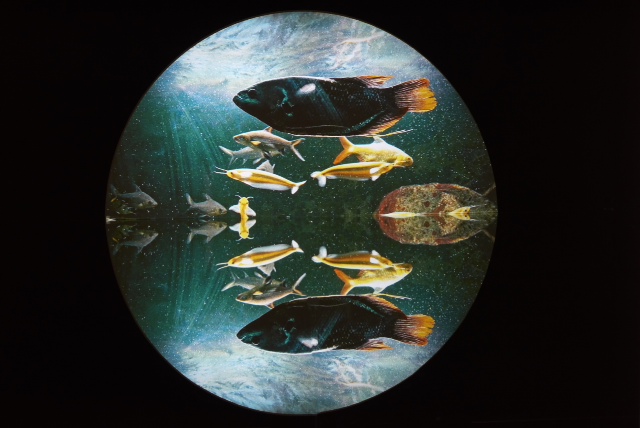

Theo Eshetu has worked in media art since the early 1980s, creating installations, video art and television documentaries. Exploring themes and imagery ranging from anthropology, art history and science to religious iconography, his films investigate how electronic media shapes identity and perception. The relationship between African and European histories and cultures often inform the London-born Ethiopian artist’s work.
The video installation The Slave Ship, 2015 takes its title from J.M.W Turner’s iconic 1840 painting Slavers Throwing Overboard the Dead and Dying – Typhoon Coming On (commonly known as the The Slave Ship). Eshetu has entirely transformed the architecture of Tiwani Contemporary’s gallery and invites the viewer to look through a window into a pitch-black space. Here a semi-circular projected image is reflected in a mirror laid out on the floor, forming a perfect orb.
This play with perception and mirrors evokes telescopic visions onto the earth. We are immersed into kaleidoscopic vistas of colourful deep sea life, merged and interspersed with sequences of high rise storage buildings in a port city, images of Turner’s Slave Ship, antique maps of the globe, enigmatic river landscapes, historic prints of the interior of a slave ship and the silhouette of a black man appearing in the dark depths of the sea.
Eshetu uses metaphors and complex layers of visual references to build his images. For The Slave Ship he loosely borrows from the legend of ‘The Flying Dutchman’, a legendary ghost ship that is condemned to sail the oceans forever by a crew of the dead. References to the myths of ‘Drexciya’, a sunken land inhabited by the offspring of pregnant African women who drowned during the Middle Passage, suggest that the ghosts of deceased enslaved men and woman still haunt the waters of European ports.
The accompanying sound-scape of diffuse Buddhist chanting and Johann Sebastian Bach’s Matthäus Passion adds to the seductive, highly aesthetic yet sombre atmosphere of Eshetu’s film.
The footage for The Slave Ship was shot by Eshetu in Hamburg, Germany, where the Swedish Africa Company traded in slaves, gold, ivory and sugar from Sᾶo Tomé from 1649. The video-art pioneer uses the port of Hamburg and references to the ocean as a powerful metaphor to investigate how the notion of tax free zones in connection with slavery have historically played a major role in the development and increase in wealth of a city like Hamburg, or other well-known European free ports such as Liverpool. At the same time his film is a hypnotic meditation on how the concept of free trade, that appears as one of the many new capitalist forms of exchange in a globalised world, reinforces inequalities and injustices that seem to have their roots in the transatlantic slave trade.
Christine Takengny
Curator
Tiwani Contemporary, 16 Little Portland Street, Marylebone, London W1W 8BP. Tuesday – Friday 11.00 – 18.00, Saturday 12.00 – 17.00. Exhibition continues until Saturday 12 August 2017. www.tiwani.co.uk

Theo Eshetu, The Slave Ship, 2015. Single channel video installation with sound, 14m 28s. Courtesy of the artist and Tiwani Contemporary. Photographer © Sylvain Deleu 2017.